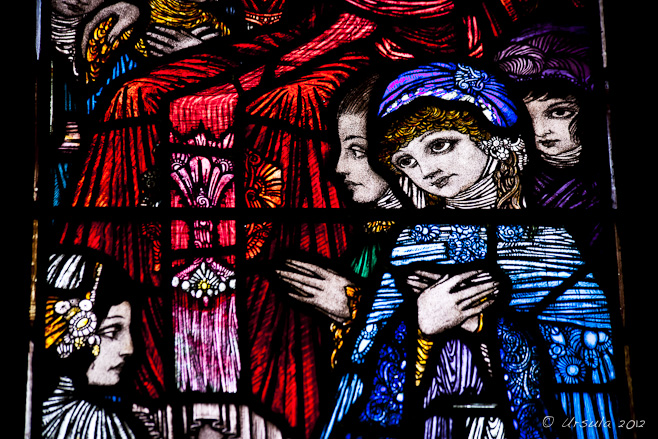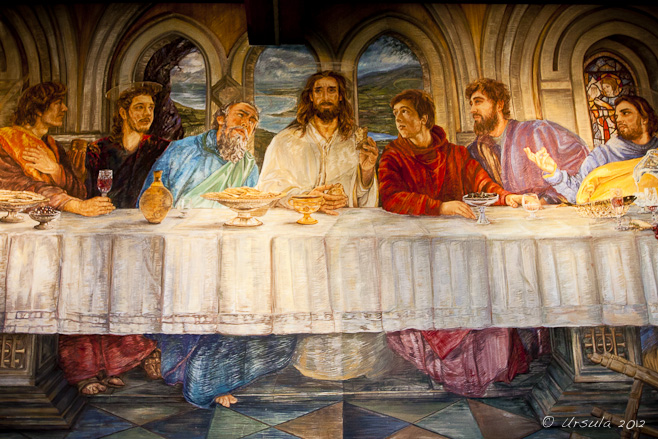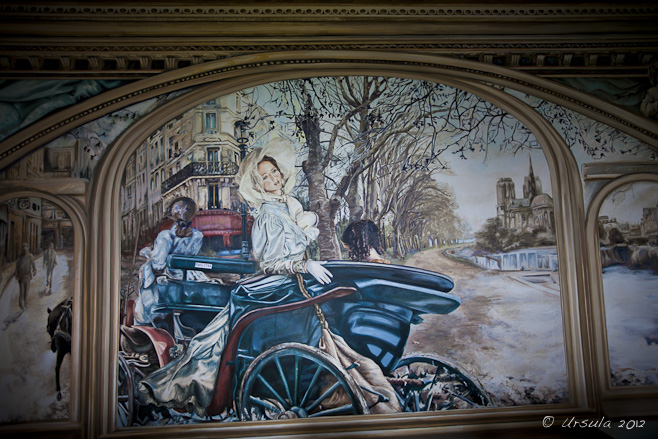
“Suffer the Children”
Detail from one of the magnificent Harry Clarke stained glass windows, DIseart, DIngle, Ireland
It’s a funny day today: the blustery winds keep changing directions as I watch the swans and pelicans on the estuary across the road from where I live.
I guess the unsettled weather is fitting for this, the last day of the cycle in the ancient Mayan calendar. For a price, you can escape or celebrate the end in a Russian bunker, while doomsday preppers in the US have their bunkers ready; just as well, really, as French authorities are banning access to Bugarach, the magic mountain and safe haven in the Pyrenees. I’ll spend the evening sitting on my balcony, come what may.
I had a fleeting moment, at some point during this year, of thinking that I might be blogging or posting a status update as the world was ending: a bizarre conceit, really – after all, if everything stops, I’m sure the electricity and internet will be the first to go! And, who would possibly be reading? But, it is perhaps symptomatic of this “connected” world we are now in, that this silly thought even crossed my mind.
As I write this, the press is still full of reaction to the recent horror-killing in the USA, half a world away: that of 20+ children and 6 adults at a Connecticut school. A tragic occurrence by any standards. But, we live in a world where, on average, 19000 children under five die every day: from disease, war, and insufficient nutrition. Those headlines are less dramatic.
Six months ago, I was in the western-most reaches of Ireland, where the rocks and the ruins seem well removed from the woes of the 21st century. Truly, as my husband and I walked around the flank of Mount Eagle, with nothing standing between us and North America except the wild Atlantic Ocean, I felt as if we were in another world.
But this rugged landscape is steeped in its own tragic history of oppression and starvation, and located in a country currently struggling through crippling unemployment.
Distance: 20 km/12.5 miles Ascent: 310 m/930 ft
Before leaving Dingle, we stopped in at Dingle’s well advertised “Hidden Treasure”: the Díseart Institute of Irish Spirituality and Culture: a former convent, housing an information centre and some absolutely fabulous religious art.

“The Last Supper”
Detail from the Fresco painted by American mural artist Eleanor Yates. The Apostles are all modelled on local men, and all the items and foodstuffs on the table are from local crafts and produce. You can see Dingle Bay through the “windows”.

Honora “Nano” Nagle (1718-1784)
Another room houses a mural depicting Nano Nagle in Paris, before her decision to live her life by Christ’s example. Later, back in Ireland, she founded the Presentation Sisters and, in spite of the risks, established several schools for the poor.

Created in 1922, the richly detailed Harry Clarke windows depict six scenes from the life of Christ.
The Harry Clarke stained glass windows are just beautiful, but there came a point at which we had to brave the rains and start walking the 20 kilometres between us and our next lodgings.

Leaving Dingle – down a wet road and into the mists…

Beautifully fragrant wild honeysuckle (Woodbine: Lonicera periclymenum) lines the roadways we followed. I was told these plants epitomise the Irish: flexible, resilient, and deceptively strong.

“Turn left at the fence.”
Ivy grows on wooden fence rails, next to galvanised gate posts.

Once off the roads, we are surrounded by honeysuckle, blackberry and fuchsia. Although not native to Ireland, fuchsia were planted as hedges by farmers and are now ubiquitous all over the southwest.

The fuchsia are much happier about the rain than we are.

White-flowers on a wet and windy Ventry Beach.

Following our guide notes, we walked the three kilometres along Ventry Beach…

… crossing streams along the way.

Clumps of grass growing in sand: Ventry Beach.

A modern house sits among the stone cottages and ruins.

Like a scene from another time: The hill is dotted with thatched stone cottages, stone and wooden fences, and beasts of burden.

Looking back towards Ventry and Dingle, we can see where we have walked.

We follow the old stone walls…

… up the hill.

We are watched by sheep…

… as we cross waterfalls.

Eventually, we spot our first clochans, or “Beehive Cells”, built by early Christian monks between 700 and 800 AD. The Blasket Islands are visible on the horizon.

These huts, like the early monasteries of Ireland, were occupied into the 12th Century. During this period, the Celtic Church was not under the direct rule of Rome, and so kept many of the early Pre-Christian influences.

Wet to the knees, we work our way through foxgloves and ferns.

The Beehive Cells are everywhere.

Under Brehon Laws in the 19th century, family plots were divided among the sons, until the farms became too small to be useful.

Stone walls still divide the countryside as we descend to the road and round the hill towards Dunquin.

The skies darken further. Daisies flank one side of the road ~

~ and the other side drops off steeply into the ocean.

Harry Clarke stained glass.
In spite of the recent hardships and poignant memories of famine, exodus, and “the Troubles”, there is a faith and resilience in Ireland that keeps the smiles, the hospitality, and the music flowing.
Christmas is just around the corner, so it is fitting to return to Harry Clarke’s windows.
Perhaps, if the world continues tomorrow, as most of us believe it will, we can fulfil the Mayan prophesy by making the world a different and better place – especially for the children.

Photos: 23June2012



.jpg)






























Lovely as always, it must be magic stepping back in time as you often do… some of these places are so quaint and gorgeous…
Ursula, a nice series as usual. Thanks for your best wishes. I wish you and your family a very Happy Christmas and an wonderful 2013.
Greetings, Dietmut
http://dith-plukeenogenblikvandedag.blogspot.nl/2012/12/blog-post_22.html